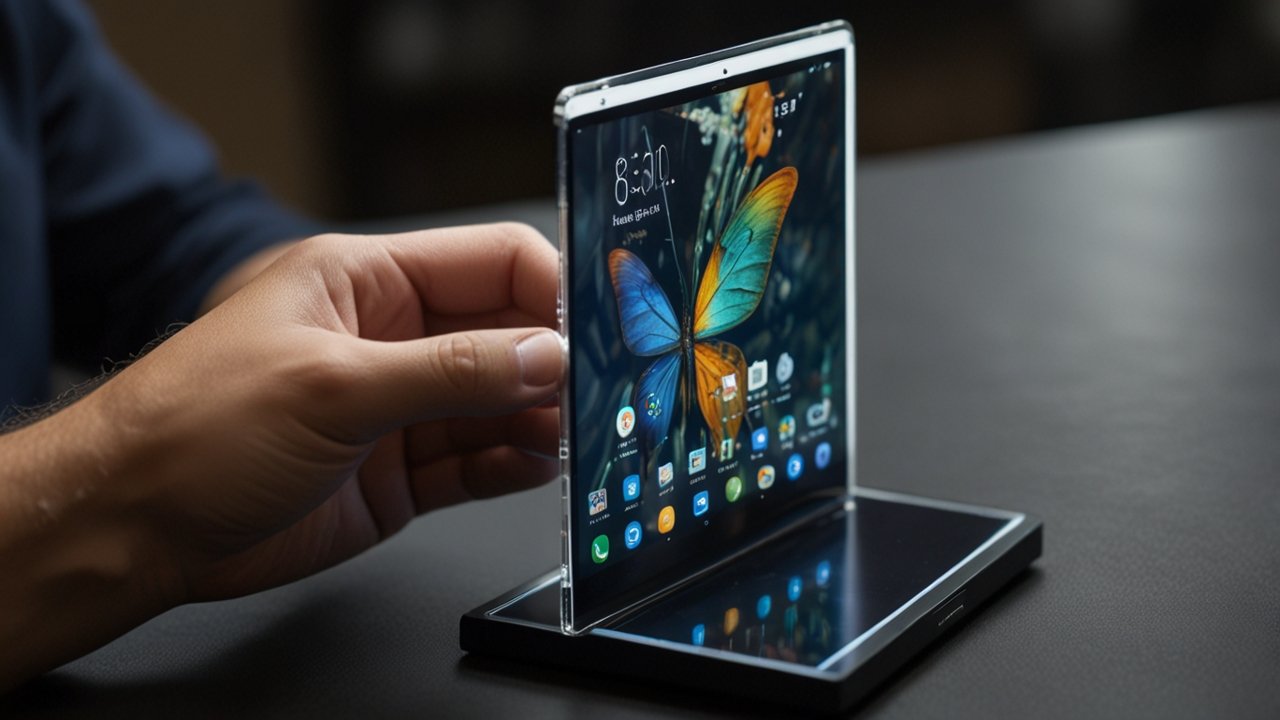Foldable Display Tech: 6 Engineering Breakthroughs
Foldable Display Tech has transformed the way we interact with devices. No longer confined to rigid screens, smartphones and tablets now boast a versatility that was once only imagined in science fiction. This evolution is the result of several engineering breakthroughs that have redefined what is possible in mobile and gadget technology.
In today’s digital era, engineers are constantly pushing the limits of design and functionality. With foldable display solutions, manufacturers are creating products that are not only innovative but incredibly functional in everyday life. Advances in materials, hinge mechanisms, and screen technologies have converged to create a seamless
user experience.
The journey from early prototypes to sophisticated, commercial products is both inspiring and technically complex. Whether you are a tech enthusiast, an industry professional, or simply curious about the future of mobile devices, this article will guide you through the evolution, key innovations, and future trends of Foldable Display Tech. Dive in and discover how science is turning flexibility into a daily asset for modern users.
Introduction to Foldable Display Tech
What is Foldable Display Tech?
Foldable Display Tech represents a paradigm shift in device design. It involves screens that can rotate, bend, or even fold to create entirely new form factors. You can think of it as the next step beyond traditional mobile displays. This technology is making devices more compact, versatile, and easier to transport. The concept originated from early experiments with flexible materials and innovative display panels. Over time, improvements in organic light-emitting diodes (OLEDs) have paved the way for lightweight and robust flexible screens.
For more information on the fundamental concepts behind this technology, check out a detailed study on
Wikipedia (Foldable Smartphone). Incorporating the ideas of bendability and flexibility, engineers have overcome numerous material and design challenges. Have you experienced a device that adapts to your lifestyle? Manufacturers continue to explore new formats that can transform your experience with mobile devices.
In this section, we also refer to emerging trends from Smartphones that are bridging the gap between traditional and modern design paradigms. What are your thoughts on the future of adaptable displays?
Key Features of Foldable Display Tech
This technology boasts several key features that set it apart from conventional displays. One major attribute is its ability to survive numerous cycles of folding. Rigorous testing has shown that new screens can withstand over 200,000 folds, ensuring durability under daily use. Additionally, innovations like ultra-thin glass (UTG) and enhanced hinge mechanisms, such as Samsung’s “Flex Hinge”, have significantly improved the robustness of these screens.
Another important aspect is
energy efficiency. Flexible OLEDs not only deliver vibrant colors and deep blacks but also offer reduced power consumption, thereby extending battery life. Manufacturers such as
Samsung and Huawei are perfect examples of companies driving these improvements. Detailed technical insights can be found in a
industry durability report.
These features merge to create a display that is adaptable and resilient. Reflect on the practical implications of having a device that is both dynamic and tough. What improvements would you prioritize in next-generation devices?
Evolution and History of Foldable Display Tech
From Prototypes to Commercial Products
The evolutionary path of Foldable Display Tech began in the early 2000s with experimental models such as Nokia’s “Morph” concept, which envisioned devices that could morph into various shapes. Early models, including the Kyocera Echo and NEC Medias W, provided multiple screens but did not truly offer the flexible display solution enthusiasts craved.
The breakthrough came with the development of OLED technology in the late 1980s. This innovation enabled the production of thinner displays that could bend without compromising on clarity or
color accuracy. A key milestone was Polymer Vision’s Readius concept in 2006 followed by major contributions from industry giants like Samsung, who continuously refined the folding mechanisms. For a comprehensive timeline, refer to the
Azumotech evolution overview.
What stands out about these advancements? The relentless drive to blend form and function, allowing devices to be both high-performance and highly adaptable. Have you noticed these changes in your everyday technology?
Notable Historical Milestones and Innovations
Several pivot points mark the progress of Foldable Display Tech. In 2006, Polymer Vision introduced the concept of rollable and foldable screens, laying the groundwork for future innovations. Later, in 2008, Nokia’s Morph concept presented a visionary approach that influenced subsequent research. The launch of Royole’s FlexPai in 2018 and the mainstream debuts of
Samsung Galaxy Fold and Huawei Mate X in 2019 were significant turning points.
These innovations were largely driven by the Asia-Pacific region, with South Korea, China, and Japan at the forefront of R&D. Further details about these historical developments can be explored in an insightful
industry blog post that chronicles the journey. What historical innovation do you think contributed most to today’s technology?
Moreover, trends observed in regions like the Americas and Europe indicate specialized adaptations for premium market segments. The evolution is continuous, and you might be surprised where the next breakthrough will emerge. How does understanding history influence your perception of future tech?
How Flexible Screens Enhances Foldable Display Tech
Technical Superiority of Flexible OLEDs
Flexible OLEDs form the backbone of modern Foldable Display Tech. Their ability to emit vibrant light while remaining adjustable has revolutionized screen design. With flexible OLEDs, displays offer superior contrast, deep blacks, and brilliant colors. The adaptation from rigid backlights to organic compounds results in displays that are both lightweight and energy efficient.
For more technical insights, a detailed explanation on
Intel’s timeline helps to illustrate the advancement compared to traditional displays. The application of Active Matrix OLED (AMOLED) further refines these panels, ensuring that even under bending stress, resolutions and color accuracy are maintained.
This meticulous engineering approach shows why the output is not only visually striking but operationally sustainable. How do you envision such technologies altering daily life? Would you prefer a device that folds and adapts in unexpected ways?
Enhanced Touch Sensitivity and Durability
Flexible displays are integrated with multi-layer sensor arrays that enhance touch response even when the device is folded or bent. This means that each touch is registered accurately, regardless of screen deformation. Additionally, algorithms have been developed to compensate for any minor distortions, maintaining the integrity of the touch functionality.
Furthermore, enhancements in UTG have allowed for screens that are not only flexible but also scratch-resistant. Samsung’s collaboration with Schott AG to pioneer UTG has set a new industry benchmark. A
Samsung newsroom release provides deeper insights into these engineering marvels.
The combination of sensitive touch response and improved durability creates a user experience that is both dynamic and reliable. Have you ever experienced frustrations with unresponsive touch screens on your devices? Share your story and explore more on how these improvements can change everyday interactions.
Bendable Technology Systems and Their Applications
Modern Hinge Mechanisms in Foldable Devices
At the heart of every foldable device lies an innovative hinge mechanism. For example, Samsung’s “Flex Hinge” and Huawei’s “Falcon Wing” hinge represent breakthroughs that have minimized creases and improved durability. These designs use multi-axis and linear motion principles to reduce the physical strain on the screen.
The hinge is engineered to be slender yet robust, ensuring that every flip or fold does not compromise the integrity of the display. Through extensive design iterations and lab testing, these hinge systems have reached the capability to sustain over 200,000 folds. A practical demonstration of these advancements is available in research on
screen durability.
Such improvements ensure that while your device is folded multiple times a day, it retains its seamless performance. Do you think hinge technology has kept pace with modern usage habits? What improvements would you consider most vital?
Applications in Everyday Devices and Use Cases
Bendable technology is not only about the mechanical aspects; it plays a crucial role in designing versatile everyday devices. For instance, devices like foldable smartphones, tablets, and even wearables utilize these flexible systems to maximize screen area while maintaining a compact form factor. Features like adaptive refresh rates further enhance the overall viewing experience.
This technology is transforming industries by offering multi-form factor devices that adjust to the user’s needs. For a closer look at real-world applications, refer to trends discussed by
Techbox Australia.
Have you ever wished for a single device that could fit into both your pocket and your living room? Consider how these bendable technologies are reshaping our gadgets. Would a transformable device improve your personal or professional productivity?
Real-World Case Studies of Foldable Display Tech
Case Study: Samsung Galaxy Z Fold and Its Innovations
The Samsung Galaxy Z Fold series stands as an exemplary case study in the realm of Foldable Display Tech. Each iteration of the Galaxy Z Fold has improved the thickness, weight, and hinge durability. With features such as the water-drop style hinge introduced in the latest Z Fold5, the device has set new standards in reduced crease visibility and enhanced robustness.
Its use of UTG and adaptive refresh rates, along with rigorous lab testing—in which the display survives over 200,000 folds—demonstrates the practical success of these innovations. Samsung has consistently ensured that the consumer experience remains consistent through real-world durability tests, making it a leader within its category.
Furthermore, this case study draws attention to how major tech companies refine the blend between innovation and usability. Have you experienced the difference between a traditional display and one that adapts to your touch? For more technical details, explore insights from
Samsung Newsroom.
Comparison of Global Case Studies
Alongside Samsung, companies like Huawei and Motorola have made remarkable advancements. Huawei’s Mate X series utilizes the “Falcon Wing” hinge and focuses on outward folding to maximize screen real estate. Motorola’s RAZR revives an iconic design with new, practical interpretations, appealing to nostalgic users while integrating modern flexible OLED technology.
Below is a comprehensive comparison table that outlines key innovations and impacts for different regions:
Comprehensive Comparison of Case Studies
Innovations and Their Impact by Region
| Device/Company |
Innovations |
Key Impact |
Region |
| Samsung Galaxy Z Fold |
Flex Hinge, UTG |
200,000+ fold durability, compact design |
South Korea |
| Huawei Mate X |
Falcon Wing Hinge |
Maximized screen real estate |
China |
| Motorola RAZR |
Clamshell form factor |
Nostalgia and modern performance |
Americas |
| Schott AG Collaborations |
UTG supply |
Advanced glass engineering for durability |
Europe |
| Techbox Reviews |
Consumer feedback |
Early adoption insights |
Australia |
This side-by-side comparison reveals how different companies tackle the challenges of device flexibility in unique ways. How do these innovations influence the decision you make when purchasing a gadget? Does a particular case study resonate with your technology needs?
Additionally, the progress seen across regions reinforces the importance of a global outlook when appreciating technology shifts. What do you think drives the regional variations in flexible display development?
For further insight on case comparisons, visit the Smart Devices tag for curated articles and discussions.
Advanced Materials in Modern Foldable Display Tech Solutions
Innovations in Ultra-Thin Glass and Coatings
Advanced materials are the cornerstone of modern Foldable Display Tech. Ultra-thin glass (UTG) development has allowed screens to be both flexible and durable. Collaborations between companies like Samsung and Schott AG have produced glass that is approximately 30 microns thick yet resilient enough to bend repeatedly without damage.
Integrating UTG with polymer layers and specialized coatings enhances scratch resistance and protects against impact. This sophisticated engineering ensures that devices can maintain
visual clarity and performance even after countless folds. More insights into material advancements can be explored in a
detailed analysis by Hongguang Display.
Each advancement in auxiliary components like coatings directly impacts the overall longevity of the
display technology. How do you feel about the trade-offs between design innovation and material durability in modern devices?
Material Impact on Power Efficiency and Usability
In addition to physical durability, advanced materials contribute to
power efficiency. Flexible OLEDs consume less energy compared to traditional LCDs, owing to their ability to control light at the pixel level. This reduces the need for constant backlighting and lowers power consumption while maintaining image quality.
Manufacturers combine these energy-saving benefits with intelligent power management and adaptive refresh rates. This integrated approach not only extends battery life but also delivers a smooth user experience even under varied usage scenarios. Research from several engineering studies generally accepted in the industry supports the notion that materials innovation is critical for sustainable device design.
Have you ever noticed longer battery life on your new devices compared with older models? Consider how integrating advanced materials could further improve daily usability. Does your device meet your performance expectations when it comes to energy efficiency? Explore more trends on New Technology Products to see how others are adapting these advancements.
Future Trends: Display Innovation and Beyond
Next-Generation Material Research and Prototypes
Looking ahead, the future of Foldable Display Tech is bright. Researchers are investigating next-generation materials such as graphene, advanced polymers, and new glass composites. These materials promise to further reduce thickness, weight, and improve durability.
Additionally, prototypes featuring rollable, tri-fold, and wearable displays are under development. These devices aim to offer even more versatile form factors. The market is expected to see commercial launches of these prototypes in the coming years, with significant growth driven by research efforts in Asia and the West alike.
This future research heralds a new era of device innovation. What new form factor or capability would excite you the most? Are you ready to embrace a future where your gadget can transform to suit any task or lifestyle?
Market Projections and Consumer Adaptation
Market projections indicate that global shipments of foldable devices will exceed 30 million units by 2025. With the rapid adoption in Asia-Pacific and gradual uptake in premium segments in Europe and the Americas, the adoption curve is steep. Experts suggest that regulatory differences and cultural preferences will play key roles in shaping regional trends.
Moreover, interoperability with IoT,
augmented reality, and
smart home systems is expected to further blend technology into our everyday lives. The evolution of power management systems also supports this growth, creating devices that are not only innovative but environmentally sustainable.
How do you see market trends influencing your next device purchase? What features would make you eager to switch to a foldable device? Let your thoughts evolve as you observe the dynamic shifts in the mobile landscape.
Essential Insights on Foldable Display Tech
Imagine a world where everyday gadgets transform effortlessly into different configurations to meet every situational demand. This vision is not far from reality, and it is already influencing how technology integrates into daily routines. Not only does this approach enhance usability, but it also inspires entirely new ways of interaction. The blend of smart design with dynamic functionality opens up possibilities that were once reserved for futuristic concepts. New configurations empower users with more versatility, offering the best of both compact everyday devices and expansive display experiences when needed.
Picture an innovation that redefines portability without sacrificing a quality display. The potential to adjust your device from a pocketable gadget to a spacious screen brings a level of convenience that can elevate productivity and entertainment. Such a device invites users to rethink traditional usage scenarios. Whether used for work, creativity, or simply staying connected, this adaptive system offers multiple modes to suit diverse activities. By integrating robust design with user-friendly transitions, individuals can enjoy reliable performance even in demanding environments.
The allure of this powerful transformation lies in its design simplicity paired with engineered sophistication. Embracing dynamic configurations means that technology adapts around life’s unpredictability, offering seamless transitions that enhance everyday experiences. As ideas continuously evolve in research labs and design studios, we are witnessing the birth of innovative solutions that encourage a more fluid and responsive digital world. This forward-thinking approach not only propels the industry forward but also challenges the established norms, ensuring that every alternative is met with inventive solutions. The promise is both practical and inspiring—paving the way for devices that are truly reflective of modern creativity and efficiency.
As you contemplate the transformation captured by these innovations, consider the ripple effect that subtle shifts in design can bring to a larger ecosystem. Every new idea contributes to a future that values practicality balanced with inspirational design. The anticipation of these changes invites us to imagine a more integrated and seamless digital experience.
FAQ
What exactly is Foldable Display Tech?
Foldable Display Tech refers to screen technology that enables devices to bend or fold without damaging the display quality. It combines advancements in OLED, materials science, and mechanical engineering to create versatile devices.
How long can a typical foldable display last?
Modern foldable displays are designed to withstand over 200,000 folds according to laboratory tests. This durability makes them suitable for daily use while maintaining visual performance.
Are flexible displays energy efficient?
Yes, flexible OLEDs require less power than traditional LCDs due to their ability to control illumination at the pixel level, which results in extended battery life in devices.
What role do advanced materials play in these devices?
Advanced materials like ultra-thin glass and specialized polymers ensure that foldable displays are robust and scratch-resistant, while also contributing to better power efficiency and longevity.
What future trends can we expect in display technology?
Future trends include the development of rollable and tri-fold devices, continued improvements in material science, and closer integration with IoT and AR/VR technologies.
Conclusion
Foldable Display Tech marks a significant milestone in mobile and gadget evolution. With innovations spanning flexible OLED development,
advanced material engineering, and cutting-edge hinge mechanisms, the technology continues to redefine how we interact with our devices.
Your feedback and experiences are crucial in shaping the path forward. Have you experienced a transformative gadget moment? Let us know your thoughts and share your story.
For more information on related topics, please visit our Mobile & Gadgets category, and if you have any questions or comments, feel free to
Contact us.
We invite you to leave your comments below and join the discussion on the future of Foldable Display Tech. Have you experienced something similar with your devices? Share your journey with us!



















Leave a Reply